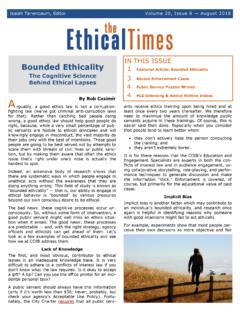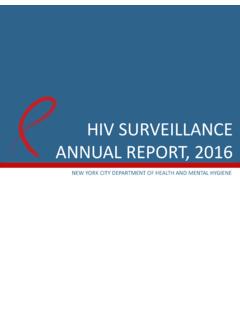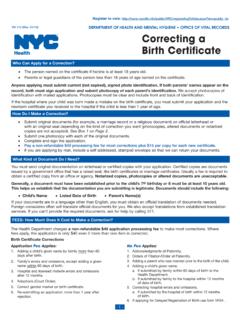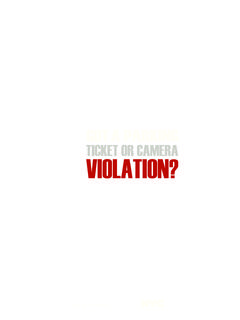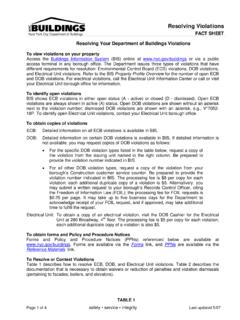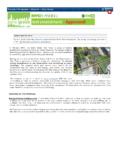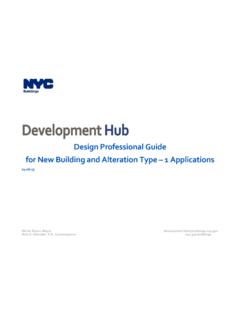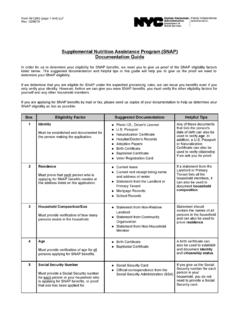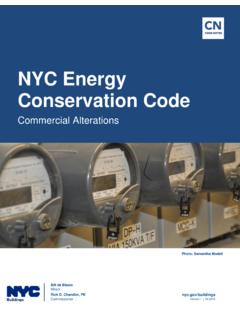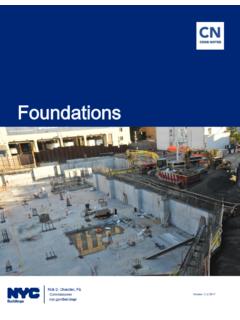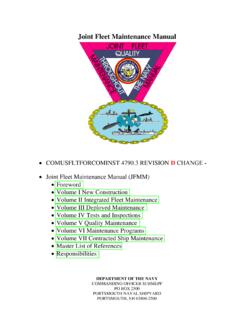Transcription of NYC Fleet Management Manual Updated January 2022
1 THE CITY OF NEW YORK Fleet Management Manual Eric Adams, Mayor Dawn M. Pinnock, Commissioner Department of Citywide Administrative Services (DCAS) Keith T. Kerman, Deputy Commissioner, Chief Fleet Management Officer NYC Fleet January 1st, 2022 1 2 NYC Fleet Management Manual TABLE OF CONTENTS Page Content Overview and Summary 3 Policy Statement 5 1. Fleet Organization 7 2. Vehicle Identification 13 3. Fiscal Resource Authorization 15 4. Acquisitions 22 5. EV Charging and Fuel 26 6.
2 Fleet Sustainability 30 7. Auction and Relinquishment 33 8. Car Share and Other Fleet Service Contracts 37 9. Assignment, Use, and Rules for City Vehicle Operators 38 10. Vehicle Maintenance 44 11. Fleet Management System 48 12. Collision and Vehicle Incident Management 51 13. Facilities 54 14. Emergency Operations 56 15. Definitions and Acronyms 57 Attachments: Executive Orders, 161, 41, and 53 City Vehicle Driver Handbook (Driver s Handbook) City Commuting Authorization and Rules Form 3 CONTENT OVERVIEW AND SUMMARY In accordance with Executive Order 161 of 2012, New York City has undertaken an extensive program to modernize and consolidate its Fleet operations Citywide and at all agencies.
3 The first NYC Fleet Management Manual ( Fleet Manual ) was completed in 2013, has been periodically revised thereafter, and has outlined the policies, rules and expectations for Fleet Management , maintenance, and operations impacting all City Fleet and equipment. The Fleet Manual has also addressed the policies that are required for all agencies involved with implementation of the Fleet Management System for the City. Since publication of the first Fleet Manual , NYC Fleet has implemented a series of initiatives in response to requirements of several local laws, Mayoral Executive Orders and City agency initiatives.
4 These have included Executive Order 53 of 2020, requiring a transition to an all-electric Fleet ; Executive Order 41 of 2019, governing Fleet telematics and Fleet size; Vision Zero and the Safe Fleet Transition Plan; NYC Clean Fleet and the Clean Fleet Transition Plan; Local Laws 41 and 56 of 2015 governing car sharing and truck side-guards; efficiency initiatives established with the Office of Management and Budget (OMB); Fleet consolidation with New York City Housing Authority (NYCHA); and a series of DOI and DCAS policies addressing the proper use of vehicles.
5 This Fleet Manual update incorporates these foregoing changes and also incorporates other rule updates. The Fleet Manual focuses on Fleet and garage operations impacting City vehicles. Another related document, the City Vehicle Driver Handbook (Driver s Handbook) focuses on employee use of City vehicles. Both manuals have been Updated . Under the City Charter, DCAS is charged with the acquisition and Management of the City s Fleet , fueling and garage infrastructure. Mayoral Executive Order 161 of 2012 established a Chief Fleet Management Officer ( CFMO) to execute these functions Citywide.
6 Each agency having a large Fleet , as listed in this Manual , appoints an Agency Fleet Director (AFD) to implement and enforce these procedures in coordination with and under the direction of the CFMO. Agencies may select the same or different staff to serve both as AFD and as the Agency Transportation Coordinator (ATC) who is responsible for monitoring employee use of vehicles as outlined in the Driver s Handbook. For agencies that do not have large fleets, the ATC oversees compliance with the requirements of the Fleet Manual . Since 2012, an inter-agency team, the Fleet Federation, has been assembled to implement Citywide Fleet policy under the leadership of the CFMO.
7 Agencies that are part of this team include Operations, OLR, OMB, DCAS, NYPD, FDNY, DSNY, DPR, DOT, DEP, DOE, DOHMH, NYCEM, TLC, NYCHA, and DOC. Additional agencies may be invited to participate as required. Because NYCHA and DOE are non-Mayoral agencies, certain aspects of their Fleet operations operate under additional agreements with DCAS. In some agencies, aspects of Fleet Management such as fuel, facilities, or collision Management are outside AFD oversight and managed by separate agency divisions. In these cases, agencies must notify the Fleet Line of Service at DCAS (NYC Fleet ) and the CFMO regarding who oversees these areas and NYC Fleet will maintain a list of these contacts.
8 4 Any requests for waivers or variances from the provisions of this Manual must be approved in writing by the CFMO. NYC Fleet can be contacted at 5 POLICY STATEMENT Purpose Over 50 agencies and offices operate City vehicles and many agencies operate their own repair facilities and fueling infrastructure. It is the expectation that Fleet and garage operations will be managed in a consistent manner across all agencies and in accordance with this Fleet Manual . In addition, wherever possible, Fleet , garage, contract and fuel resources are to be shared and coordinated among agencies to the benefit of all City agencies.
9 NYC Fleet will work with agencies to outline service expectations and implement sharing and consolidation of Fleet resources. Agency heads and Agency Fleet Directors (AFDs) may develop supplemental rules and procedures to address specific Fleet requirements related to the operation of their agency s Fleet , particularly as impacts law enforcement and emergency vehicles as addressed in the Driver s Manual . All agency Fleet procedures must be consistent with the general requirements set forth in this Manual and shall be approved by the CFMO.
10 AFDs are required to distribute these rules to all supervisors and staff engaged in Fleet operations and also to ensure that all operators receive the Driver s Handbook, which is now part of the Fleet Manual . Employees who have access to NYCAPS Employee Self-Service (ESS) through DCAS may download the rules forms directly. An employee download will establish a record that they have received the forms. Agencies must confirm that an employee has received these rules before that employee may be authorized to drive a City vehicle. This Manual includes the following policy initiatives and changes: Fleet consolidation and sharing in accordance with Executive Order 161 of 2012; Fleet Efficiency and Tracking, in accordance with Executive Order 41 of 2019; All- Electric and Safe New York City Fleet , in accordance with Executive Order 53 of 2020; Compliance with Fleet , fuel and vehicle tracking systems in accordance with DCAS and DOI Fleet oversight requirements.
